Frankie Lymon and the
Teenagers
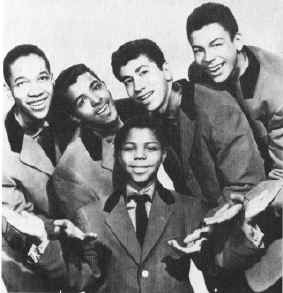
(L-R) Jimmy Merchant, Herman Santiago, Joe Negroni,
Sherman Gaines
Bottom: Frankie Lymon
As lead vocalist with the Teenagers, Frankie Lymon became the
first black teenage singing idol. The group's success inspired
the formation of a number of youthful black vocal groups, from
the Students in the late '50s to the Jackson Five in the '60s.
The group's sound influenced young singers such as Ronnie Bennett
and Diana Ross, and served as prototype for both the girl groups
and early Motown groups of the '60s.
Members:
Frankie Lymon - lead
Herman Santiago - first tenor
Jimmy Merchant - second tenor
Joe Negroni - baritone
Sherman Gaines - bass
After forming several short term vocal groups, two black
students from Edward D. Stitt Junior High School in the
Washington Heights section of New York city, Jimmy Merchant and
Sherman Garnes recruited neighborhood Puerto Ricans Herman
Santiago and Joe Negroni for the group. They called themselves
the Premiers and hoped some day to make a record.
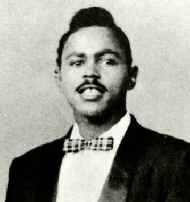
Richard Barrett
The Premiers were working on a song they had written called
"Why Do Birds Sing So Gay" and needed a high tenor.
Richard Barrett, a member of the Valentines, lived above
the grocery store where Frankie Lymon worked part time. Through
him they got together with Lymon who suggested changing the focus
of the song and it's title. The song would be known as "Why
Do Fools Fall In Love"
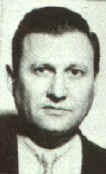
George Goldner
The Valentines were under contract to Rama Records owned by
George Goldner. Barrett a talent scout for Goldner arranged an
audition. Goldner was impressed. At subsequent recording sessions
bandleader Jimmy Wright suggested a name change to the Teenagers
to reflect the members ages.
Early February, 1956 "Why Do Fools Fall in Love" was
released. With Lymon on boyish soprano lead, the song became an
instant smash on Gee Records. The song was subsequently covered
by the Diamonds and Gale Storm, but unlike most songs rendered by
white artists, the original proved to be the biggest hit. The
Teenagers were on their way.
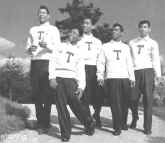
Sporting a clean-cut wholesome image, the appeal of the
Teenagers was their youth. On stage they were very energetic. The
group was well choreographed by Cholly Atkins who would go
onto greater fame with the Temptations. The Teenagers were
packaged so as not to upset middle lass American parents. They
even appeared in letter sweaters.
March, 1956 they were booked by Alan Freed in one of his rock
and roll reviews at the Brooklyn Paramount. They appeared with
the Platters and Bill Haley and His Comets. A second single
"I Want You To Be My Girl" was released in April. A
week later they appeared on CBS-TV's Shower of Stars. By the end
of April they were touring with "The Biggest Rock and Roll
Show of 1956"
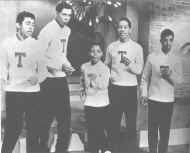
Photo from the film Rock, Rock, Rock.
In August production was begun on a movie called Rock.
Rock, Rock in which the Teenagers made a cameo appearance.
In September they appeared on Alan Freed's radio show. While
headlining the Apollo "ABC's of Love" was released.
After that they went back to Hollywood to film a cameo for Don't
Knock the Rock. In late September they began a tour with
Bill Haley that lasted until late November. In November their
fifth single "Baby, Baby" was released and their first
album Meet the Teenagers was released in December. The
Teenagers were enrolled in the School for Professionals. and on
the road they took correspondence courses and had traveling
tutors. However, they were falling behind in their
education and the group stayed at home the first of months
of 1957. During this time "Paper Castles" was released
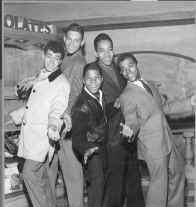
After appearing in a carnival in Panama in March
they began a three month tour of England beginning at the London
Palladium. While in London, the Teenagers recorded a second album
Frankie Lymon and the Teenagers at the London Palladium.
George Goldner had been trying to convince Lymon to go
solo and after the success in Great Britain he agreed to do
so. On Alan Freed's weekly television show in July Lymon
appeared solo. "Goody Goody," his the last record
with the Teenager was released in July.
In September Lymon began an 80 day tour with the Biggest
Show Stars for 1957 as a solo act. His first record without
the Teenagers, "My Girl" was released.. In November
Lymon's "Little Girl" appeared on Roulette and the
Teenagers "Flip-Flop" on Gee
January 1958 Lymon released "Thumb, Thumb" Lymon and
the Teenagers reunited to sing "Goody Goody" on Dick
Clark's "American Bandstand. In June he appeared with the
Coasters at the Apollo Theater.
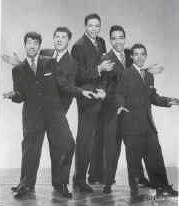
Teenagers after Frankie Lymopn left
Left to right Joe Negroni, Billy Lobrano, Sherman Garnes,
Jimmy Merchant, and Herman Santiago
Losing his youthful soprano voice, at the age of fifteen
Lymon's career was in decline. After the initial success of the
first two records sales had slipped with each release.
"Goody, Goody" was the last record by Lymon or the
Teenagers to have any significant sales.
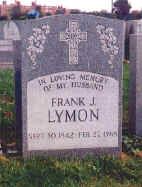
Lymon had experimented with drugs since
1958. On June 21, 1966 he was arrested on a heroin charge. Lymon
entered the army in lieu of a jail sentence but, received a less
then honorable discharge a short time later. He moved to
Fort Gordon, Georgia where he married a local school
teacher Emira Eagle and stayed in the Augusta area appearing at a
local lounge. In mid-February he told his wife he had a weekend
job in New York. On February 27, 1968 he died in the same house
he had grown up in with an empty syringe by his side.
As with most young performers of the era, the Teenagers lost
rights to their material. Goldner's publishing firm had handled
the song, taking fifty percent off the top. Originally Frankie
Lymon, Herman Santiago and George Goldner were listed as
"Why Do fools Fall In Love" composers. Santiago's name
was soon dropped and in the mid-sixties Lymon and Goldner sold
off their rights to the song. Goldner allegedly to pay gambling
debts and Lymon for money to buy drugs.
In 1984, on behalf of Emira Lymon, a lawyer and artist's agent
sued to wrest the copyright away from the current owner. The case
became confused when it looked like Lymon had a second and
possibly a third widow. Elizabeth Waters claimed to have married
Lymon in 1964 in Virginia. However, it turned out she had been
married to someone else at the time. As Water's claim went to
court, Zola Taylor ex-member of the Platters, claimed that she
had been sexually active with Lymon as early as the "Biggest
Rock "n" Roll Show of 1956" tour. She claimed to
have married Lymon in Tijuana about 1965, but could produce
no certificate. The first hearing, held in Philadelphia, was
decided in favor of Miss Waters being Lymon's first wife. Emira
appealed and won a reversal based on her claim that she was
Lymon's last wife.
Herman Santiago and Jimmy Merchant also pursued their claim to
the songs rights in federal court. In December, 1992, the two
singers and Emira Lymon, received complete rights to the song.
By 1980, Sherman Garnes (heart attack) and Joe Negroni
(cerebral hemmrage) had both died when the remaining Teenagers
decided to rebuild the group. Santiago and Merchant performed
with Garnes' brother, while the high tenor parts were
handled by Pearl McKinnon of the Kodiaks, and later by Frankie's
brother, Lewis Lymon
Frankie Lymon has been called the "father" of the
girl group sound. He was a direct influence on Arlene Smith of
the Chantels, Little Anthony and the Imperials, and the Isley
Brothers, all who recorded for George Goldner.
Frankie Lymon and the Teenagers were inducted into the Rock
and Roll Hall of Fame in 1993
Frankie Lymon and the Teenagers were inducted into the Vocal
Group Hall of Fame in 2000
Jimmy Castor died of heart failure January 16, 2012 in
Henderson, Nevada at the age of 71.
Joe Negroni died of a cerebal hemorrhage September 5, 1978 at the
age of 37.
Sherman Gaines died February 26, 1977 from a heart attack at the
age of 36.








